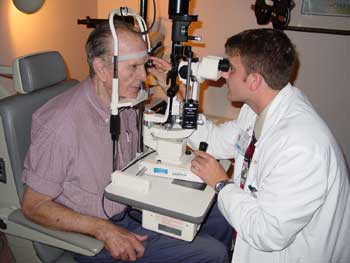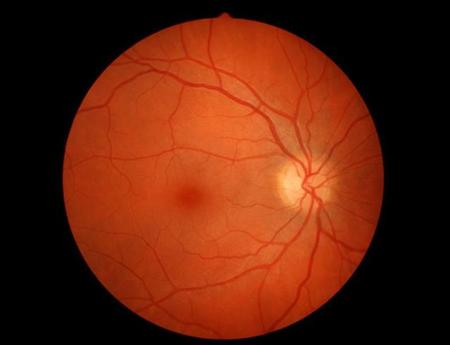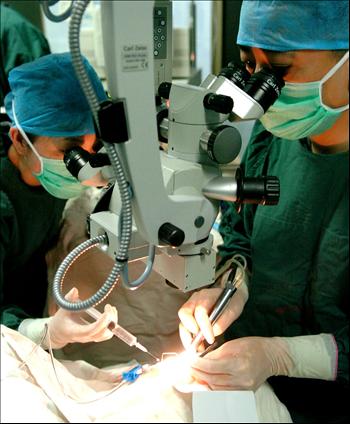Med 3 July rotation: Ophthalmology
When I first started this blog as my senior year of college was winding down, medical school was just a few months away. My original vision was, sure, to have the gaming and entertainment discussion you currently see on here, but also to document my progression through med school. The first 2 years are the basic science years where we learn anatomy, biochemistry, pathophysiology of diseases, etc. Mostly lots of rote memorization in the classroom so nothing terribly interesting to write about, though cadaver dissection might be something I can go into sometime.
In July, I began Med 3, which is the start of the clinical years. This is when we rotate through the various general divisions of medicine (like surgery, internal medicine, pediatrics) and actually work in the hospitals and clinics. Each rotation is two months long (though some are divided into multiple parts) and I’ve decided to write an overall impression as I finish each one.

The rotations are randomly assigned to the students so that not everybody is taking the same rotation at the same time. July-August was my ambulatory rotation, which means basically out-patient, office visits. It was split into two parts: one month was family medicine while the other month was a selective where we can pick from a variety of disciplines. I opted for ophthalmology (eye doctor/surgeon).
I like to think of third year of medical school (Med 3) as a shopping trip that will determine the direction of the rest of my life. This is the year to get a flavor for all the different branches of medicine, to see how doctors in certain fields work and live, to see if I can imagine myself doing this kind of work for a career. Medical schools encourage 1st and 2nd year students to spend some time shadowing other doctors to see what their work is like, but I didn’t find shadowing to be useful because you can only spend a couple hours with them and don’t do anything other than following them around.
So while you have to work hard during rotations to learn the clinical material in order to see patients, you’re also simultaneously evaluating the type of work and lifestyle of these doctors. Both ophthalmology and family medicine have great work hours, but the former is much more desirable and competitive because of the higher salaries.

We only had about 6 lecture days in our Med 1/2 curriculum dedicated to ophthalmology, and since it’s such a specialized field, my ophthalmology rotation was quite unique. In fact, it was almost like an entire month of shadowing, ironically enough. I was able to get plenty of practice using the ophthalmoscope and slit lamp to examine patients’ eyes, but the doctors took the lead in talking to the patients and completing clinical visits. Unlike other rotations, the point of this one wasn’t to train us into becoming mini-ophthalmologists.
I was very fortunate to have my first rotation be ambulatory because of the fantastic, easy-going hours. I had just returned from summer vacation and was not in the right frame of mind for intense work hours. My comrades in other rotations like surgery or internal medicine had obscenely long days, but for ophthalmology, work started at 9 AM and frequently ended at 4 PM. Lifestyle? Awesome.

The coordinator organized a great schedule for me and I ended up working with about 8 or 9 different doctors over the course of a month. Retina, neuro-ophthalmology, general ophthalmology, glaucoma… it was fun to have such a great variety of fields to explore and everyday was something new.
I also spent several days in the month scrubbing into the OR and watching surgeries all day. Most cases were bread-and-butter cataract removals, but there were a couple crazy cases, like an oculoplastics surgery on a patient with a skin tumor near his eyelid. A chunk of his eyelid and part of his face had to be removed, and a patch of skin from his shoulder was cut out and grafted onto his face as a replacement. I watched with morbid interest as the resident helping with the surgery cleaned the shoulder skin patch with a surgical tool, scraping the fat off the skin with the same matter-of-fact manner as a chef during food prep.

Because I worked with such a variety of ophthalmologists, it was interesting to see how much their personalities reflected which specific field they worked in. Many doctors have certain stereotypes — orthopedics are commonly depicted as gruff carpenters, for example. One cataract doctor I worked with was extremely earnest and had many elderly patients with very poor vision, some only able to detect light. I was chatting with her about the kinds of surgeries she does and asked her about LASIK. As she explained to me, “My patients would be happy just to have ‘count-fingers’ vision again. I could never do LASIK procedures because I would go crazy working with patients complaining about their 20/50.”
Sounds rather cynical, but a couple weeks later, I worked with an ophthalmologist specializing in laser refractive surgery (basically LASIK). He was nice to me, but what a startling contrast in physician personality and patient population! He seemed to be personal friends with a lot of his patients and would chat with them all throughout the visit about upcoming boating trips and expensive sports cars. His patients seemed to include a disproportional number of well-off big shots and CEOs who smelled of money. Quite a different world indeed.
I imagine this is the exact same situation as with plastic surgeons: some operate on burn victims and genuinely disfigured people, then you have those who line up a row of women for tummy tucks, boob jobs, and Botox injections. Each profession attracts a certain type of person.

Overall, ophthalmology is a fantastic rotation. I’ve always had a fascination with this field starting from college, where I volunteered in a post-op ophthalmology nursing station. The doctors I worked with throughout the rotation were all very helpful and bent over backwards to make sure I was learning. The mechanics of operating an ophthalmoscope and slit lamp isn’t the tricky part. Correctly diagnosing minute details indicating harmful changes in the eye takes a while for residents, let alone medical students.
I have to thank them for being very patient with me. All the doctors that take medical students are volunteers. They don’t get paid any extra, yet they have to deal with students slowing down their workflow. Luckily, the patients realize they’re being treated in a large university teaching hospital system, so not too many of them are unhappy about waiting.
My next school-related post will be about family medicine, the second half of my ambulatory rotation. Quite a very different experience, as I was assigned to a family clinic in a small town an hour’s drive away. More next time!
